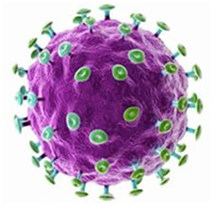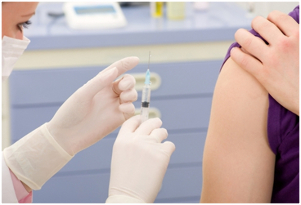
The human papilloma virus (HPV) is a serious cause of morbidity and mortality all over the world. Today is one of the most common viruses sexually transmitted diseases. The threat of virus infection affected a large part of the population of different ages.
Every tenth of people on the planet train from this virus.
Some types of diseases related with HPV negative impact on the reproductive function of women. Celebrated mass for the identification of new cases of oncology of the female reproductive system, associated with papillomavirus infection.
From history.
Lesions of the skin and mucous membranes and are known to the humanity is already more than a millennium. Under the name of "spike" have been described by the doctors of Ancient Greece. Of particular importance, as the infection is acquired at the end of the TWENTIETH century. The viral nature of warts was demonstrated at the beginning of the last century, about the sexual transmission routes of the infection reported in 1954.
Frequency condylomatosis between the young people and middle-aged:
- 1981-1986 5.4%
- 1987-1999 19.1%
- currently - up to 60%.
What is human papillomavirus infection?
Human Papillomavirus chronic infection is a viral disease transmitted from person to person through sexual contact.
This infectious agent.
The causative agent of the disease -the human papilloma virus (HPV) is the common name for more than 80 types of viruses that cause a variety of diseases of the skin and of the mucous membranes of the body. Each virus group HPV has a sequence number.

The human papilloma virus is detected:
- on the skin
- the mucous membranes of the oral cavity
- mucous membranes, conjunctival
- the mucosa of the esophagus
- the mucosa of the bronchi, larynx
- the mucosa of the rectum
- the genital mucous
The transmission of the virus.
The transmission of the virus takes place only from person to person. The main route of transmission is sexual.
Are also possible:
- contacts-electrical household appliances via the transmission of infection in the presence of money - epithelial virus can penetrate into the human body through scratches and abrasion, the virus from one infected person remains in a Turkish bath, a gym, swimming pool, on a towel, an electric razor
- the medical staff can become infected by inhalation of dust during removal, laser genital warts, become infected through surgical instruments
- transmission to the child from the mother during pregnancy
The factors that contribute to the onset or recurrence of HPV:
- Hypothermia
- Hormonal disorders
- Medical manipulation (abortion, the introduction of an intrauterine device)
- Pregnancy
Group HPV-infections
- The HPV do not lead to cancer (warts on the skin in the beings)
- Low-risk HPV to the development of tumour diseases (different types of warts on the genitals)
- high oncogenic risk (tumor diseases in women and men)
The prevalence of HPV-related diseases throughout the world
- 21 000 - Cancer of the vulva and vagina (women)
- 40 000 - Anal cancer (Among men)
- 60 000 - Anal cancer (Among women)
- 530 000 - the Cancer of the neck of the uterus (for women)
- 17 300 000 - genital warts (Among men)
- 14 700 000 - genital warts (women)
The incubation period of hpv infection can last from 2 months to 2 to 10 years, with an average of 3 months.
For human papillomavirus infection is typical of a hidden.
The clinical picture of the.
To various infections. Can spontaneously disappear, then again to progress.
Distinguish 3 forms of the disease:
- clinical - visible papillomas
- subclinical - no visible manifestations, asymptomatic for you, it only reveals another examination (colposcopy or cell research)
- latent - is only defined for the analysis of the blood
The main symptoms of hpv infection is the appearance of:
- warts;
- papillomas - soft growths that are attached to the skin, thanks to the peduncle;
- genital warts - growths with rough surface (especially appear around the anus and the genitals).
Many of these symptoms, it is necessary to pay attention in the first place.
Consequences of infection by the human papilloma virus:
- Cancer of the neck of the uterus is at the second place in the list of causes of mortality of women. The duration of life of people affected women is reduced, on average, for 26 years. It has been shown that 70% of the cases of cancer of the neck of the uterus is caused by HPV 16 and 18 types.
- Cancer of the neck of the uterus - completely avoidable if the disease is revealed at an early stage of the cancer or precancerous.
- Cancer of the vulva and vagina.
- The anal cancer. Every year there are about 100,000 cases of this type of cancer.
- Cancer of the penis. It is called in 35% of cases of HPV 16 and 18 HPV 6 and 11-5% of the cases.
- Anogenital warts. Are caused by HPV 6 and 11. According to WHO, every year in the world is registered more than 30 million cases of venereal warts.
- Cancer oropharyngeal area young men.
How to determine the presence of the virus in the body and its type?

In the majority of cases the infection is asymptomatic, then the patient is usually only found with the help of special analysis.
The diagnosis of HPV can include:
- the clinical examination of the patient;
- examination of the cervix;
- Polymerase chain reaction (PCR) - an efficient diagnosis method, which can determine the type of virus;
- cytology - under the microscope in the study phase of the forecast cell (the smear on the cervical cytology);
- blood analysis for the determination of antibodies to the HPV virus (this method is used very rarely);
- biopsy - during the diagnostic procedure of "suspicious place" (for example, of condyloma or warts) take particles out of the fabric. Is assigned, if there is suspicion that the patient has cancer.
What is the pap test?
This is a test, with which you can define pre-cancerous or cancerous cells of the vagina and the cervix. With the surface of the neck of the uterus or of the channel special spatula is taken of the smear. The recovered material is applied on the glass, and sent to a lab, where the doctors-lab technicians, carefully study the cellular structure. The test is called with the name of the scholar Greek Georgios Papanikolaou.

When and to whom it is necessary to perform the Pap test?
- The pap test is necessary to make every woman at least once a year starting from 18 years of age or the beginning of sexual life. In the case of the absence of sexual relations, the analysis is valid for 1 time in 3 years.
- Twice a year, the pap test is recommended during the use of hormonal contraception, and women who suffer from genital herpes.
- The opportunity for more frequent surveys atypia are frequent changes of a woman of sexual partners, overweight (obesity), infertility, the presence of genital warts genital.
The prevention of papillomavirus infections.
Considering the particular risk for this infection, the lack of effectiveness of existing methods of treatment, of primary importance is the prevention of this infectious disease.
The non-specific prevention:
- the sexual education of adolescents
- limit the number of sexual partners
- the use of a condom reduces the risk of transmission of HPV
- the screening of the cervix, which is a regular examination of women with Pap test (swab of the cervix) for early diagnosis and treatment of the disease
- stop smoking
Specific prevention:

Vaccination against the most dangerous (oncogenic) types of HPV boys and girls in the age of 12-13 years before the beginning of sexual life and the potential contact with HPV. After the vaccine is formed persistent immunity.
Why is it necessary to vaccine against human papillomavirus infection?
The human papilloma virus causes the malignant transformation of cells, i.e. are the cause of cancer, in particular cancer of the neck of the uterus.
In recent years has the rapid growth of the frequency of genital cancer in men, because of all of this the question about the introduction of a HPV vaccination of both genders.
Currently, HPV vaccination is included in the calendar of vaccination in 57 countries of the world, six of them have introduced the vaccination of both sexes.
The effectiveness of vaccination reaches 98-100%, which has been shown in clinical studies.
The HPV vaccination is most effective before the beginning of sexual life, but it is advisable to all the women of a young age.
The introduction of large-scale vaccination will prevent up to 80-82% of all the tumors of this group.
The prevention of papillomavirus infections is one of the most important components of prevention of cancer of the neck of the uterus in women and some types of cancer in men.























